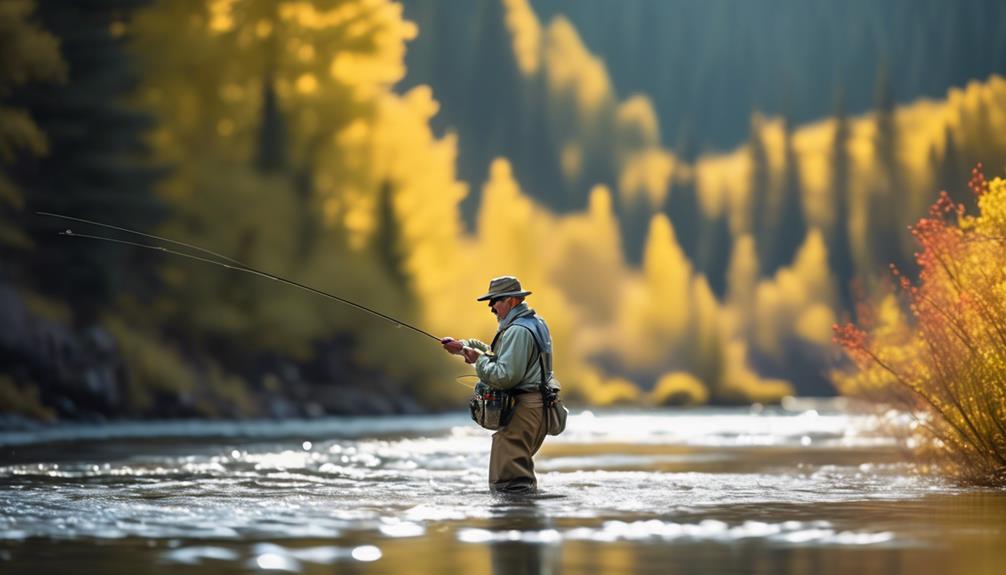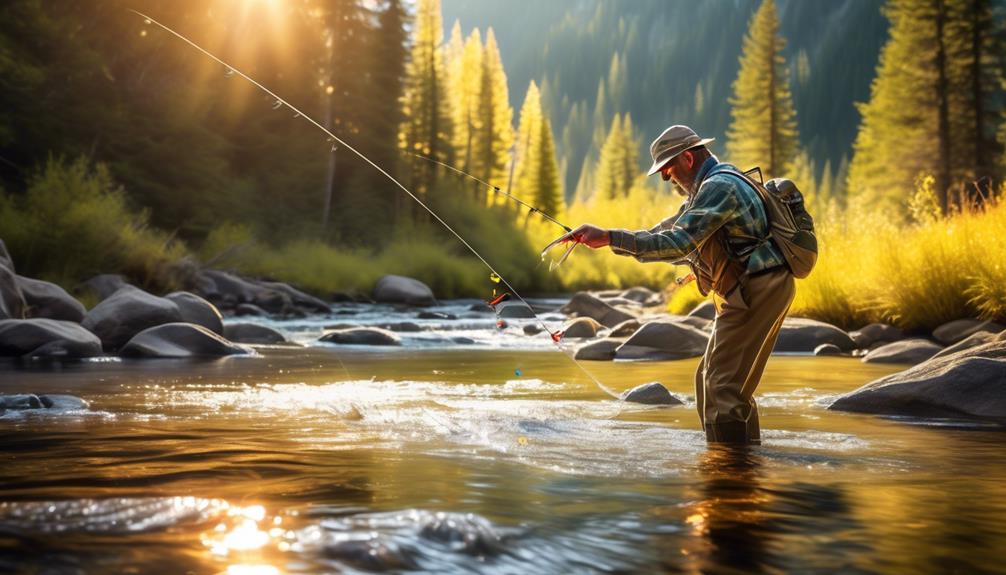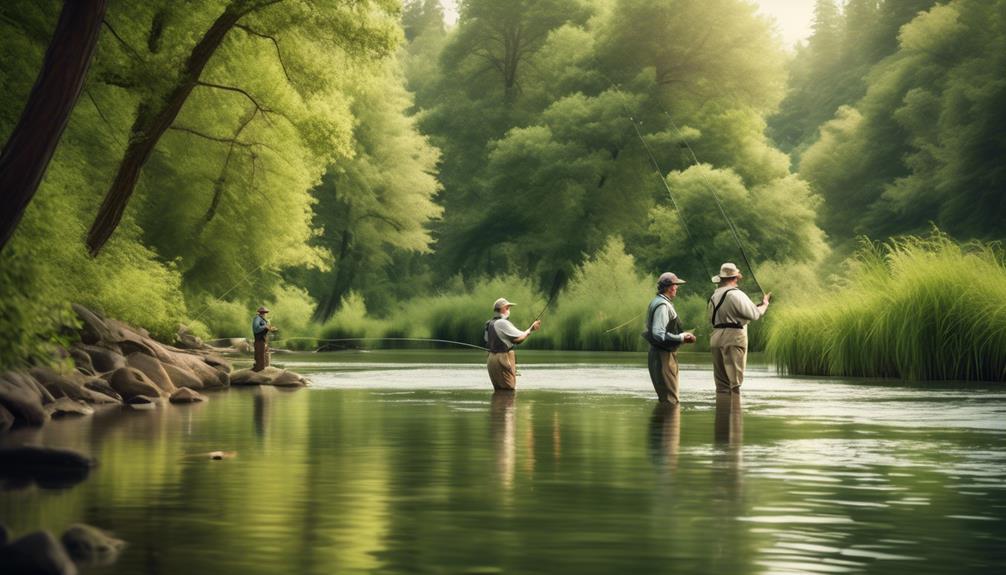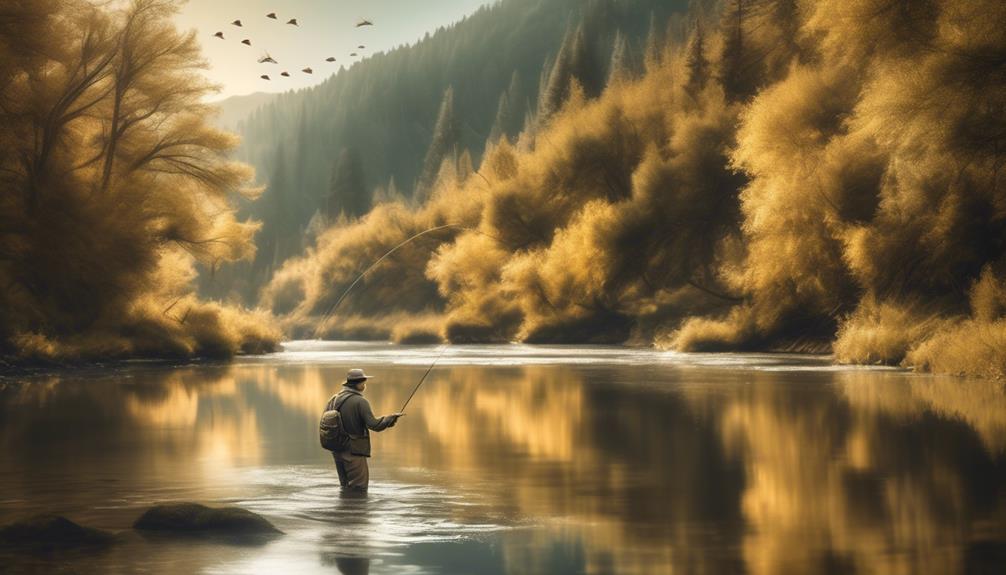When it comes to enticing trout in fly fishing, it's like unlocking a treasure trove of techniques that can elevate your angling game. Each method is a key that opens up a world of possibilities, and it's up to you to find the right one to unlock the secrets of successful trout luring.
These eight techniques are tried and tested, but there's always room to refine your skills and discover new approaches that could make all the difference in landing that elusive catch.
Dry Fly Fishing
To effectively engage in dry fly fishing, carefully observe the water's surface for rising trout before selecting the appropriate fly to imitate the natural insects. Once you have identified rising trout, it's essential to approach the water cautiously to avoid spooking them. Make sure your casting technique is precise, allowing the fly to land gently on the water's surface, mimicking the natural insect's landing. Achieving a drag-free drift is vital in dry fly fishing. This means that the fly should float naturally on the water, following the same path as the current, without any unnatural movements that could alert the trout.
Matching hatches is another key aspect of successful dry fly fishing. Observing the insects present in the area and selecting a fly that closely resembles them is essential for enticing trout to bite. Pay attention to the size, shape, and color of the natural insects to choose the most appropriate fly for the conditions. Additionally, understanding the life cycle of the insects and selecting a fly that represents a stage of their life cycle can significantly improve your chances of success.
Nymphing Techniques
Observing the insects present in the area and selecting a fly that closely resembles them is essential for successful nymphing techniques in fly fishing. When nymphing, you'll want to focus on casting accuracy and maintaining precise line control to effectively imitate the movement of underwater insects.
Here are some key tips to improve your nymphing techniques:
- Use a strike indicator: A strike indicator can help you detect subtle strikes, especially when nymphing in deeper or faster waters.
- Adjust your depth: Experiment with the depth at which your nymph is drifting to find the optimal position where the trout are feeding.
- Mend your line: Proper line mending is crucial for achieving a natural drift. Being able to mend your line effectively will help you avoid drag and keep your nymph drifting naturally in the water.
- Master the dead drift: The dead drift mimics the natural movement of nymphs in the water. Practice maintaining a drag-free drift by adjusting the speed of your line to match the current.
- Set the hook quickly: When you feel a strike or notice any unusual movement of the indicator, swiftly set the hook to secure your catch.
Streamer Fishing
When fishing with streamers, focus on presenting the fly in a lifelike manner to entice trout to strike. Streamer fishing is an exciting and effective technique for targeting aggressive trout. To maximize your success, pay attention to streamer retrieval and streamer selection.
Streamer retrieval plays a crucial role in streamer fishing. After casting your streamer, utilize various retrieval techniques to mimic the movement of baitfish or other prey. One effective method is the strip-and-pause retrieve, where you strip in the line to impart movement to the streamer and then pause to allow it to sink or dart. Another technique is the swing retrieve, where you allow the current to move the streamer across the water, simulating a fleeing baitfish. Experiment with different retrieval methods to determine what entices trout in a particular fishing spot.
In streamer fishing, streamer selection is key. Choose streamers that imitate the prevalent baitfish or aquatic insects in the trout's environment. Consider the size, color, and silhouette of the streamer to match the natural prey. For example, in a river with sculpin, a dark-colored, bulky streamer may be effective. In contrast, in a stream with minnows, a slender, silver streamer might be more successful. By selecting the right streamer, you increase the likelihood of enticing strikes from trout.
Mastering streamer retrieval and streamer selection will enhance your streamer fishing success, ultimately leading to more exhilarating trout catches.
Wet Fly Swing
As you advance your fly fishing skills, mastering the art of the wet fly swing can open up new opportunities to entice trout in varied water conditions. This technique involves casting the wet fly across the current and allowing it to swing downstream before retrieving.
Here are some key points to consider when employing the wet fly swing:
- Swing presentation: Focus on the natural movement of the fly as it swings across the current. Vary the speed of the swing to mimic the behavior of insects or baitfish.
- Mending techniques: Use mending to control the speed and depth of the swing. Mend upstream to slow down the swing and allow the fly to sink, or mend downstream to speed up the swing and keep the fly near the surface.
- Wet fly tactics: Experiment with different wet fly patterns to determine which ones are most effective in the current conditions. Consider using soft hackles, traditional wet flies, or small streamers for enticing trout.
- Hook setting strategies: When a fish takes the fly during the swing, resist the urge to set the hook immediately. Instead, allow the line to tighten and the fish to turn away before setting the hook with a firm but controlled motion.
Mastering the wet fly swing requires patience and observation. By understanding the nuances of swing presentation, mending techniques, wet fly tactics, and hook setting strategies, you can significantly increase your success in luring trout with this method.
Czech Nymphing
To master Czech Nymphing in fly fishing, focus on the precise presentation of weighted flies to entice trout in fast-flowing streams. Czech nymphing is a highly effective technique for catching trout, especially in swift currents where traditional dry fly or indicator nymphing may not be as successful.
One of the key aspects of Czech nymphing is the variations in the technique and effective fly patterns used.
When it comes to Czech nymphing variations, there are a few different approaches that anglers can take. One common variation is the French leader technique, which involves using a long, level leader to effectively present the weighted nymphs in the water. Another variation is the Spanish nymphing technique, which utilizes a longer rod and longer leader to cover a larger area of water. These variations allow anglers to adapt their approach to different water conditions and trout behavior.
In terms of effective fly patterns for Czech nymphing, there are a few go-to options that consistently produce results. The Hare's Ear Nymph, Pheasant Tail Nymph, and the Czech Cat's Whisker are all popular choices among fly fishers practicing Czech nymphing. These patterns are designed to imitate the aquatic insects that trout feed on, making them highly effective for enticing strikes.
Euro Nymphing
Euro Nymphing offers a highly effective approach for enticing trout in both fast and slow-moving currents, using weighted flies and specialized techniques. This method involves using a long, light rod and a thin tippet to feel the bottom and detect subtle strikes.
Here are some key aspects to consider when using the Euro Nymphing technique:
- Tight Line: Keeping a tight line is crucial in Euro Nymphing. By maintaining direct contact with your flies, you can detect even the slightest bites and effectively set the hook.
- Weighted Flies: Euro Nymphing relies on heavily weighted flies to get down to the feeding zone quickly. These flies are designed to sink fast and stay close to the riverbed where trout are likely to be feeding.
- Specialized Techniques: This technique involves a range of specialized casting and drift techniques, such as the 'French,' 'Polish,' and 'Spanish' styles, which allow for precise control and presentation of the flies.
- Subsurface Focus: Unlike traditional dry fly fishing, Euro Nymphing primarily targets subsurface feeding trout. It's a highly effective method for catching trout in challenging conditions and heavily fished waters.
- Versatility: Euro Nymphing can be effective in a variety of water types, from fast-flowing riffles to slow, deep pools. Its adaptability makes it a valuable technique for anglers in diverse trout fishing environments.
Indicator Fishing

You've just learned about Euro Nymphing, a highly effective technique for enticing trout in various water types. Now, let's explore the strategy of Indicator Fishing to further expand your trout luring repertoire.
Indicator Fishing is a popular method for targeting trout in rivers and streams. It involves the use of a small, floating indicator attached to the leader above the nymph or other subsurface fly. This indicator serves as a visual cue, allowing you to detect strikes and also aids in controlling the depth at which your fly is drifting.
Depth control is crucial in Indicator Fishing. By adjusting the distance between the indicator and the nymph, you can effectively target trout at different water depths. This is particularly useful when trout are holding at specific depths in the water column.
Furthermore, mending techniques play a vital role in Indicator Fishing. As the current moves your indicator and fly downstream, mending the line—using techniques such as the reach mend or stack mend—helps eliminate drag, allowing for a more natural drift of the fly at the desired depth.
When employing Indicator Fishing, pay close attention to the indicator for any sudden movements or hesitations, as these can indicate a trout has taken the fly. Setting the hook promptly upon detecting such movements is essential for a successful hookup.
With proper depth control and adept mending techniques, Indicator Fishing can be a highly effective method for luring trout in various water conditions.
Terrestrial Patterns
When fishing with terrestrial patterns, focus on presenting the fly near likely feeding areas to entice trout to strike. Terrestrial patterns imitate insects that aren't aquatic in nature, such as grasshoppers, beetles, and ants. These insects often find themselves blown onto the water, making them an enticing meal for trout.
Here are some tips for using terrestrial patterns effectively:
- Grasshopper Imitations: Use realistic grasshopper imitations to mimic the large, juicy insects that often fall onto the water. The buoyancy of these patterns allows them to stay afloat, making them an easy target for hungry trout.
- Hopper Dropper: Try using a hopper dropper setup, where a buoyant grasshopper imitation is used as the indicator fly with a smaller nymph or emerger pattern trailing behind. This can increase your chances of enticing trout, as they may be drawn to the larger grasshopper before noticing the smaller nymph.
- Beetle Patterns: Beetle patterns are effective when trout are feeding close to the banks or in shallow water where beetles are commonly found. These patterns are often smaller and darker in color, mimicking the appearance of real beetles.
- Ant Patterns: Ant patterns can be incredibly effective, especially during the summer months when ants are prevalent near water. These small, dark-colored patterns can provoke aggressive strikes from trout.
When using terrestrial patterns, it's crucial to observe the water's surface for signs of feeding trout and to cast your fly strategically to entice a strike.
Frequently Asked Questions
What Are the Best Fly Fishing Spots for Catching Trout?
You'll find the best rivers for catching trout by researching local fishing reports and asking experienced anglers. Look for spots with abundant insect activity and use ideal flies like nymphs and dry flies to entice the trout.
How Do I Properly Maintain My Fly Fishing Gear for Trout Luring?
To properly maintain your fly fishing gear for trout luring, clean your equipment after each use to prevent damage, store it in a dry place to avoid rust, and perform regular maintenance to ensure optimal performance.
What Are Some Effective Strategies for Approaching and Casting to Trout in Different Water Conditions?
When approaching trout in varying water conditions, consider fly selection and casting accuracy. Adjust tactics based on water temperature and river structure. Be mindful of these factors to effectively target trout in different environments.
Are There Any Specific Techniques for Targeting Larger Trout in Fly Fishing?
To catch big trout in fly fishing, try advanced techniques taking into account trout behavior. Focus on luring techniques that appeal to larger trout and adapt your approach based on their behavior in different water conditions.
What Are Some Common Mistakes to Avoid When Fly Fishing for Trout?
When fly fishing for trout, avoid common mistakes like improper fly selection and overcasting techniques. Proper presentation is key to success. Focus on accuracy and finesse, and you'll improve your chances of luring in those elusive trout.
Conclusion
So, whether you're using dry flies, nymphs, streamers, or any other technique, there are plenty of effective ways to lure trout in fly fishing.
With the right approach and a bit of practice, you can improve your success in catching these elusive and beautiful fish.
Keep experimenting with different techniques and patterns to find what works best for you, and enjoy the thrill of reeling in a prized trout on your next fishing trip.



